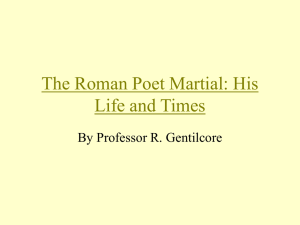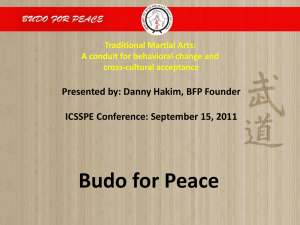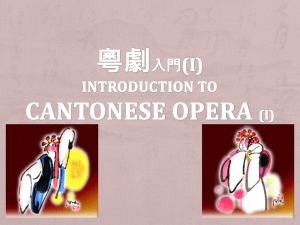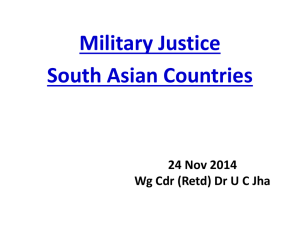Martial Arts as an Intervention for Pediatric Patients
advertisement
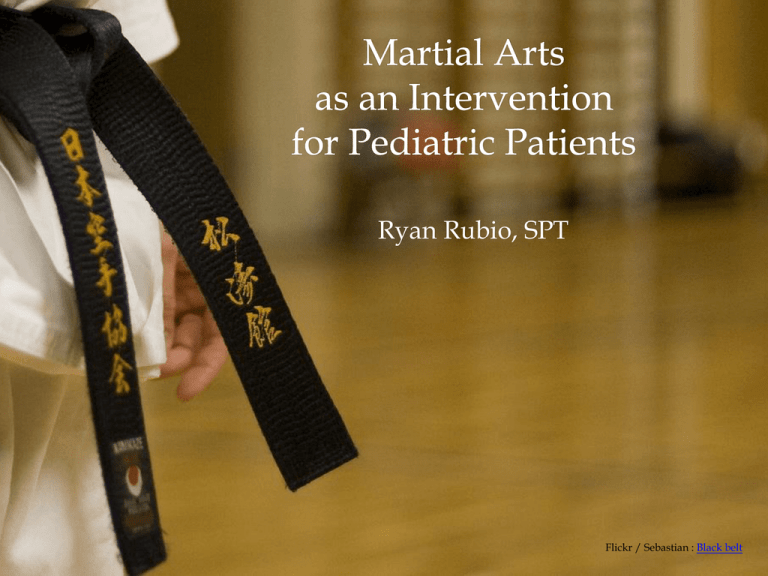
Ryan Rubio, SPT Flickr / Sebastian : Black belt Objectives Provide a definition of martial arts Discuss the research findings Give pediatric physical therapists basic techniques that they can use Creative Commons: Flickr / Michael Holler - Alicia Stewart from USA doing a yop chagi in Moon-Moo. First round in the ITF Taekw on-Do Worlds 2007 in Quebec. Original file What Are Martial Arts? Wikimedia Commons/Cpl. Kristin E. Moreno: A taekwondo student on the Kyung Hee University Demon Team launches off a student to kick a board being held by another student during the Exercise Foal Eagle 2010 Korean - U.S. Friendship Event. Styles of Martial Arts Some of the more common styles include: Taekwondo highlights discipline, respect, and personal growth and focuses on kicking techniques. 1 Karate is a traditional Japanese form that is normally practiced without weapons.1 Judo is known for a variety of throwing techniques. 1 Styles of Martial Arts Kung fu is one of the oldest forms, and is mainly known for its powerful blocks. 1 Aikido teaches a nonaggressive approach to selfdefense, focusing on joint locks, throws, and restraining techniques. 1 Jujutsu emphasizes techniques that allow a smaller fighter to overcome a bigger, stronger opponent, focusing on ground fighting and grappling. 1 That’s me in 1995! Why Use Martial Arts? Martial Arts can do the following: provide a therapeutic activity. keep kids engaged. give a therapist more treatment options. Creative Commons / Flickr / Sean Dreillinger: original file Aspects of Martial Arts Practice Stances Kicking Bilateral upper extremity use Jumping and spinning Breathing Katas Creative Commons/ Flickr / Republic of Korea: K Tigers The K Tigers Taekwondo provides world-class teaching and training the Korean martial arts emphasizing respect, health and fitness. Wikimedia Commons/Cpl. Kristin E. Moreno: A taekwondo student on the Kyung Hee University Demon Team jumps to kick a board being held by another student during the Exercise Foal Eagle 2010 Korean - U.S. Friendship Event. What does research show? Creative Commons: Flickr/Derek Mueller Developmental Coordination Disorder After three months of Taekwondo subjects showed improvement in these areas2-6: single-leg stance time vestibular function lower limb strength Autism Spectrum Disorder An 11-week martial arts program resulted in these changes7: improved balance and play skills. more frequent eye contact. fewer instances of disruptive behaviors. Deficits in Executive Function Martial arts sessions included physical activity and required each student to answer three questions8,9: Where am I? What am I doing? What should I be doing? Children with Epilepsy After a martial arts intervention there were positive trends in these outcome measures10: Parenting Stress Index Quality of Life in Childhood Epilepsy questionnaire Piers-Harris Children’s Self-Concept Scale Attention Deficit Hyperactivity Disorder There is a belief that various aspects of Martial Arts practice can reduce impulsivity and improve concentration in children with ADHD, but further research is needed to confirm this.11 Creative Commons: Flickr/Flavio Karate Summer Camp 2013 Link Martial Arts and Aggression Research indicates that practicing martial arts does not foster aggressive behaviors.11, 12 It is important that the martial arts instructor emphasizes a proper attitude of respect and responsibility. Creative Commons / Flickr / Bart: Advancing martial arts students bowing in respect. Wheelchair Martial Arts Video: Wheelchair kata Video: Wheelchair karate Video: Martial arts and United Cerebral Palsy Video: Wheelchair self defense YouTube/Joe Demanuele: Wheelchair kata More Research Is Needed Several studies do not show statistically significant improvement after a martial arts intervention. There are few well-designed studies. Most positive findings come from case studies or anecdotal evidence. Martial Arts in Action Amy Sturkey, a PT in the Charlotte, N.C., area has found that martial arts-themed physical therapy: provides a good alternative to “typical physical therapy.” helps children who have had trouble transitioning into community-based, gross motor-oriented recreation programs. Martial Arts in Action The classes are used for children with a wide array of deficits. Every child has a one-on-one assistant in addition to the karate instructor and the PT. The PT and karate instructor work collaboratively to meet the needs of each child and to modify each exercise as needed. Amy has seen her clients improve their balance, UE/LE strengthening, motor planning, bilateral coordination, endurance, social skills, and group-play skills. Flickr /Kevin Makice : Balance A Rewarding Experience Her clients who can’t stand, walk or even sit on their own enjoy the opportunity to do things that their typically developed peers take for granted. They often work harder in a martial arts-themed session than they do during typical PT. Amy believes martial arts are an effective medium for PT, similar to hippotherapy and aquatic therapy. My Clinical Rotation Experience My Clinical Rotation Experience Testimonials “Emotional and physical benefits were observed during [Juan's] karate sessions with Ryan. [Juan] began smiling more, sitting up straighter in his power wheelchair and initiating conversations with more confidence. He was eager to demonstrate his karate moves to school staff and peers. With karate, [Juan] demonstrated a connection and true sense of excitement regarding physical exercise, that had not been observed in the previous months.” -Shelley Rhudy, MPT Testimonials "Martial arts was an excellent motivator for a child with attention and balance difficulties, and it can be tailored towards the child's interests and functional needs. The young man we did martial arts with had difficulty with balance and trunk rotation. With every kick, punch, and block, he was willingly challenged to work on impairments that he otherwise was likely to become frustrated with and walk away. Martial arts is a good activity for peers to work on as well. I had a young lady who did better with a classmate model. They enjoyed taking turns blocking and 'karate chopping.' The blocking was excellent for hand eye coordination and balance. The chopping for power, endurance and trunk rotation." -Melissa Scales, PT, DPT Finding Instruction Call local martial arts schools and speak with the head instructor. Make the family aware that bumps and bruises can happen. The physical therapist should accompany the family to the first lesson. Contact the city parks and recreation department to see if they provide any lessons or activities. Thank You References 1. Healthy Children.org. Healthy Living: Martial Arts. Available at: http://www.healthychildren.org/English/healthy-living/sports/Pages/Martial-Arts.aspx. Accessed November 22, 2013. 2. Fong SS, Tsang WW, Ng GY. Taekwondo training improves sensory organization and balance control in children with developmental coordination disorder: a randomized controlled trial. Res Dev Disabil. 2012 Jan-Feb;33(1):85-95. doi: 10.1016/j.ridd.2011.08.023. Epub 2011 Oct 4. PubMed PMID: 22093652. 3. Fong SS, Chung JW, Chow LP, Ma AW, Tsang WW. Differential effect of Taekwondo training on knee muscle strength and reactive and static balance control in children with developmental coordination disorder: a randomized controlled trial. Res Dev Disabil. 2013 May;34(5):1446-55. doi: 10.1016/j.ridd.2013.01.025. Epub 2013 Mar 5. PubMed PMID: 23474997 4. Fong SM, Ng GY. Sensory integration and standing balance in adolescent taekwondo practitioners. Pediatr Exerc Sci. 2012 Feb;24(1):142-51. PubMed PMID: 22433259. References 5. Fong, SM William W.N. Tsang, Relationship between the duration of taekwondo training and lower limb muscle strength in adolescents, Hong Kong Physiotherapy Journal, Volume 30, Issue 1, June 2012, Pages 25-28, ISSN 1013-7025, http://dx.doi.org/10.1016/j.hkpj.2011.11.004. 6. Fong SS, Tsang WW, Ng GY. Altered postural control strategies and sensory organization in children with developmental coordination disorder. Hum Mov Sci. 2012 Oct;31(5):1317-27. doi: 10.1016/j.humov.2011.11.003. Epub 2012 Jan 4. PubMed PMID: 22221468. 7. Bahrami F, Movahedi A, Marandi SM, Abedi A. Kata techniques training consistently decreases stereotypy in children with autism spectrum disorder. Res Dev Disabil. 2012 JulAug;33(4):1183-93. doi: 10.1016/j.ridd.2012.01.018. Epub 2012 Mar 22. PubMed PMID: 22502844. 8. Lakes KD, Hoyt WT. Promoting self-regulation through school-based martial arts training. Journal of Applied Developmental Psychology, Volume 25, Issue 3, May–June 2004, Pages 283-302. References 9. Diamond A, Lee K. Interventions shown to aid executive function development in children 4 to 12 years old. Science. 2011 Aug 19;333(6045):959-64. doi: 10.1126/science.1204529. Review. PubMed PMID: 21852486; PubMed Central PMCID: PMC3159917. 10. Conant KD, Morgan AK, Muzykewicz D, Clark DC, Thiele EA. A karate program for improving self-concept and quality of life in childhood epilepsy: results of a pilot study. Epilepsy Behav. 2008 Jan;12(1):61-5. Epub 2007 Oct 17. PubMed PMID: 17923439. 11. Woodward TW. A review of the effects of martial arts practice on health. WMJ. 2009 Feb;108(1):40-3. Review. PubMed PMID: 19326635. 12. Trulson, M.E. (1986) Martial Arts Training: A Novel "Cure" for Juvenile Delinquency. Human Relations 39: 1131-1140 Additional Articles Itamar N, Schwartz D, Melzer I. Postural control: differences between youth judokas and swimmers. J Sports Med Phys Fitness. 2013 Oct;53(5):483-9. PubMed PMID: 23903528. Liberman L, Ratzon N, Bart O. The profile of performance skills and emotional factors in the context of participation among young children with Developmental Coordination Disorder. Res Dev Disabil. 2013 Jan;34(1):87-94. doi: 10.1016/j.ridd.2012.07.019. Epub 2012 Aug 30. PubMed PMID: 22940162. Strayhorn JM, Strayhorn JC. Martial arts as a mental health intervention for children? Evidence from the ECLS-K. Child Adolesc Psychiatry Ment Health. 2009 Oct 14;3(1):32. doi: 10.1186/1753-2000-3-32. PubMed PMID: 19828027; PubMed Central PMCID: PMC2766365.

